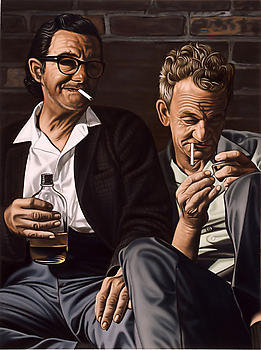Richard Phillips
dal 13/3/2009 al 1/5/2009
Segnalato da
13/3/2009
Richard Phillips
Gagosian Gallery - Madison Ave, New York
New Museum is a series of nine monumental paintings. Over the last decade, Phillips has developed a striking signature style that derives its tension from his selective use of popular images that he subjects to the technical, value-laden refinements of academic painting. For Phillips, critique is as much an intrinsic material in the conception and staging of his paintings as the canvas and paint with which they are made.

"At its core, this show is the conflict between capitalism, fascism, and communism. It looks into the nature of representation, propaganda, and misinformation, and how they redirect the ideologies of institutions."
--Richard Phillips
Gagosian Gallery is pleased to present "NEW MUSEUM," a series of nine monumental paintings by Richard Phillips.
Over the last decade, Phillips has developed a striking signature style that derives its tension from his selective use of popular images that he subjects to the technical, value-laden refinements of academic painting. For Phillips, critique is as much an intrinsic material in the conception and staging of his paintings as the canvas and paint with which they are made. His deft and selective scrambling and conflating of subject and genre continues to provide challenging comment on the condition and reach of painting in our time. As a self-conscious American painter weaned on postmodern appropriation strategies, Phillips is an active protagonist in the continually evolving discourse on the many lives and deaths of painting and how this interacts, throughout history, with the complex politics of making and reading images.
"NEW MUSEUM" construes painting as an act of civil disobedience rather than one of benign compliance with existing aesthetic conventions. Phillips's term for this is "paintertainment". The title of the exhibition derives from a photograph from a 1973 issue of Hustler magazine of two men slouching against a wall on the Bowery in New York (now the location of the New Museum of Contemporary Art). By appropriating this image and rendering it as a large and detailed oil painting, Phillips alludes to how, in his view, institutions such as the New Museum employ propaganda to promote their agendas, at the same time as he challenges the status of these institutions as vehicles of cultural authority.
In Message Force Multiplier, Phillips transposes a male model originally photographed for a United States Marine Corps recruitment advertisement into a bucolic Swiss landscape, refocusing attention on the artifice and gloss of this 'heroic' image. In Der Bodensee (the alpine lake spanning Germany, Austria and Switzerland), Phillips takes a "beauty shot" (the close-up that is a feature of both porn and fashion shoots, focusing on the facial beauty of the model) of a model in an upside-down erotic pose, crops it then sets it against the same idyllic landscape background. In Frieze and Fundraiser, erotically posed women evoke the ever shifting threshold where art and commercial interests intersect with increasingly negative connotations, whether through art fairs or magazines. Evoking the potentially explosive implications of these competing interests, SUMKA and The Dead Do Not Revolt (After Aslan) deal with potent symbols of power and revolution. In the former it is the emblem of the Iranian neo-Nazi party containing vestiges of the German swastika; in the latter, it is an image of Fidel Castro appropriated from a photograph of a "body painting" by the notorious erotic illustrator Aslan. In Aslan's original painting, Castro's face appears inscribed on a woman's abdomen and genitals in a blunt negation of his carefully proscribed image of revolutionary masculinity, complete with phallic cigar.
By manipulating, recombining, and amplifying all manner of sexual, social, political, commercial, and artistic imagery, Phillips's incisive and at times repugnant compositions continue to challenge the concept of fixed and predetermined meanings in visual culture while proposing an altogether new meaning of the term "history painting."
Born in Massachusetts in 1962, Richard Phillips lives and works in New York. His work is collected by public and private institutions including the Albright-Knox Art Gallery, Buffalo, NY; the Denver Museum, CO; the Modern Art Museum of Fort Worth, TX; the Museum of Modern Art, New York; the Museum of Contemporary Art, Miami; UBS Paine Webber Art Collection, New York; San Francisco Museum of Modern Art; Tate Modern, London; Van Abbemuseum, Eindhoven, The Netherlands; and the Whitney Museum of American Art, New York.
Opening reception: Saturday, March 14th, from 6 to 8pm
Gagosian Gallery
980 Madison Ave - New York
Tue-Sat 10-6
Free admission



